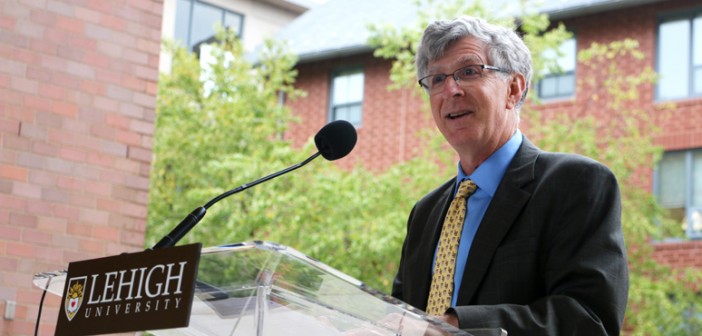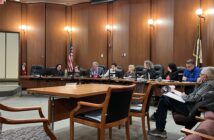President John Simon spoke with The Brown and White for the first time since his Sept. 4 announcement that he would step down at the end of June 2021.
Simon described the past few months of managing Lehigh during the COVID-19 pandemic as “24/7.”
“Largely living and experiencing Lehigh during the pandemic and what I think Lehigh needs in leadership (is why I made the decision to step down),” Simon said. “Lehigh needs someone willing to make a long-term commitment.”
Despite signing a contract extension through 2025 last year, Simon said he has “always viewed the job” as year-to-year and said he made that mentality known.
As for next steps, Simon said it’s still too early to tell — but knows one thing for sure.
“I am in no way thinking of the same position at another university,” Simon said. “The whole process (these past few months) was first thing in the morning until late at night seven days per week.”
Simon said one of the hardest decisions Lehigh had to make when developing its reopening plan was to arrange for first-years to live in single rooms and not have sophomores live on-campus.
But, with no on-campus cases of COVID-19 so far this semester, Simon said he’s “very cautiously optimistic” the university is responding well to the new health guidelines in place. He also said he’s pleased to see Northampton County with low numbers of cases.
Simon responded to concerns regarding Lehigh’s testing strategy that “fully remote” students aren’t required to get tested through the Health Center, though some are still living off-campus in Bethlehem, and that the routine testing of students the first two weeks of classes has stopped. Simon said Lehigh is continuing to evaluate “what kind of surveillance testing is appropriate.”
All students — fully remote or not — have access to the Health Center should they experience COVID-related symptoms.
Simon acknowledged the financial hit the pandemic has brought on Lehigh. He announced on June 1 that Lehigh was facing a $40 million budget shortfall and had been forced to freeze hirings, suspend raises and contributions to faculty and staff retirement plans, and temporarily furlough some staff members.
While Simon said Lehigh has been “well managed over the years,” he acknowledged there is work to do.
“We have not addressed the long-term aspects and restructuring as to what will take place,” he said. “It’s critical, the steps we’ve taken to mitigate this year, but who knows what spring semester will look like?”
Lehigh’s presidency isn’t the only top-level position experiencing recent change. In March, Lehigh picked Nathan Urban as the university’s provost following Pat Farrell’s decision to leave the post. Urban began his role over the summer.
Calling Urban “the perfect fit,” Simon said he hopes his transition with his successor goes as well as it has gone at the provost position.
“I think Lehigh is at one of those pivot points,” Simon said. “It’s the right time to pass the baton.”






Comment policy
Comments posted to The Brown and White website are reviewed by a moderator before being approved. Incendiary speech or harassing language, including comments targeted at individuals, may be deemed unacceptable and not published. Spam and other soliciting will also be declined.
The Brown and White also reserves the right to not publish entirely anonymous comments.
7 Comments
I’m watching administrative chaos across universityland, and the jump in bond sales at elites, and thinking that the model has finally snapped. I’m thinking the administrative jobs are now untenably difficult or just impossible to do. Too much power is now in the hands of trustees and regents, who are very far out of touch with current student-market realities; the state and federal governments have pulled too far back from funding higher ed; an insupportable burden now falls on both families and universities trying to pull very wealthy students (for private Us) or out-of-state upper-middle-class students (state Us) while also keeping contractual promises to an aging tenured professoriate and trying to serve the hundreds of thousands (millions?) of kids every year who want an education.
And the number of people who can actually pay the “you’re on your own” rate just isn’t there anymore, even before you get to covid. The middle class is gone to the point where there just aren’t enough rich kids to go around, and the Gen Z kids aren’t so willing to take on gigantic debt for a bachelor’s degree, nor are their parents running out so often for PLUS loans. And college isn’t a fun, carefree time if you’re waking up every morning in dread of the debt you’re in the middle of accumulating.
My Lehigh friends are sending their kids to school in-state, state schools. They don’t want to do this, they know how lousy the education is. But it’s all they can afford on their low-six-figure salaries, which still put them in the top 5th-10th percentiles nationally. My kid’s taking a local state-U course as a high-schooler and is shocked by how nothing it is, less demanding than an AP course. If she doesn’t get very hefty fin aid somewhere in the US, she’ll likely go to college overseas. In one of those countries where nobody takes on lifelong debt for a college education and they bother to have a reasonable tax structure. I have an easier time seeing a future for her there than I do here, come to think of it.
I had a long, candid talk with a dean here yesterday. They’ve got a good team, they’re shoulder to the wheel, really trying to make things go. And the semester here is a shitshow anyhow because of lunatic decisions taken far up the chain, beyond their control. As we talked I realized I was being gently recruited to go tell the students how to protest at the right people. Which I will do, but I don’t think it’ll do much good. Again, too much greed, too much attention to the next set of numbers and not enough to what’s beyond that. I don’t even know where our university president is these days; his spox won’t say, so we assume he’s at his multimillion-dollar chalet-mansion in another state. Meanwhile we’ve got ridiculously underpaid contingent faculty, TAs, and others striking this week for the right to stay out of covid-ridden classrooms and teach remotely.
The danger is that as students, administrators, persistently exploited contingent faculty, and young people thinking about the professoriate walk away from a broken, impossible system beset by greed — inside the university, yes, but on a much larger scale outside it — the political decision is “see, nobody wants or needs universities.” And then it’s a death spiral and we’re back to an age when only the vastly privileged have the opportunity to go to university, and as a nation we fall farther and farther behind other countries’ economies and quality of life.
Simon, I’m sure you worked your ass off; I’m sure you were also overpaid. Have a good retirement.
Lehigh has a faulty business model
As such, both Simon and the Board of Trustees should be replaced.
A recent article describes how this sort of business model is common throughout academe
https://www.philanthropydaily.com/unsustainability-in-higher-education
The author makes some interesting points with regards to higher education’s unsustainable “business model”.
He says:
~~~~~~~~~~~~~
The irony here is that as universities have righteously funneled resources into the study of sustainability, they have been practicing a business model that is profoundly unsustainable.
For the past forty years, that model has run something like this: 1) hike tuition, 2) expand administration and student services, and 3) build fancier facilities, in order to 4) justify further hikes in tuition. That’s how you reach a point where the price of college is increasing at eight times the rate of wages, with students shouldering an average cost of $30,000 per year (more than twice that at many private schools) and accruing upwards of $2 trillion in student debt in the process.
This model of perpetually escalating costs has been sustained by increasing demand—both in the domestic population and, crucially, among international students willing to pay sticker price to attend college in the U.S. It has not led to higher quality education. Quite the opposite, in fact. Universities have outsourced the actual business of teaching to a contingent labor force of part-time and adjunct instructors, loosened academic standards, and generally invested very little in what actually takes place in the classroom.
In short, the higher education model regnant in the United States today looks less like a sustainable 21st century ecosystem and more like the subprime mortgage-backed securities market around 2007—a lousy product kept afloat by continual expansion.
But all good Ponzi schemes must come to an end, even in the hallowed halls of higher ed. Enrollment numbers have stagnated or declined since 2011, leading many colleges on the margins to declare bankruptcy or merge with larger ones.
I don’t see anything to argue with there. I’d just add that the attitudes about what kind of money you’re supposed to make in higher ed, especially public higher ed, have been corrupted in the general turn away from “public” and towards radical selfishness. For a while I was having conversations weekly with people who make multiples of what takes to live nicely here and who were still sour because doctors made more, lawyers made more, coaches made more. People trying to push me at more money, too. And I’d say, “Have you noticed that we have kids now who don’t even show up because they can’t afford a state university education? What do you need more money for?” And they’d tell me about how the salaries were higher at peer institutions. Come to think of it, someone did that at me just yesterday. The guy makes four times what I do and has a wife with a business. Decent guy, too, it’s just he’s picked up what’s become the normal way of looking at this.
It took a lot of pushing to get those attitudes to that place. It took the whole culture backing away from any idea of public service and from paying taxes for any public institution. The idea that you’re going to sock away a million bucks as a professor at a public institution — this would have been an obscene idea 40 years ago, but now people admire that professor, and what a saint he is for endowing a $1000/yr scholarship in his old department.
If Biden wins I have some small hope that we’ll be able to bother teaching the kids and setting them up well for life again. If he doesn’t, well, I think it’s over. In the meantime I am slowly sorting through the obstacles to setting up independently in a way that can do well by the kids and not actually impoverish the faculty, can provide stability for them and a reasonable standard of living. A major problem is accreditation, which is very expensive, because without that the students can’t get federal loans, so the question is really whether we can do it cheaply enough that they don’t need federal loans. It’s possible that a microlending facility could do the job.
This article can be summed up by this hypothetical statement
. . .Golly, the job of president has become really difficult with the need to make tough decisions. I am clueless as to what to do. It is driving me nuts. So I’m quitting.
Infinitely more likely:
“Even I have limits when it comes to robbing people and playing fall guy for gazillionaires in the name of education. Also, this system is broken, good luck finding another sucker somewhere.”
Simon said. “Lehigh needs someone willing to make a long-term commitment.”
Despite signing a contract extension through 2025 last year, Simon said he has “always viewed the job” as year-to-year and said he made that mentality known.
The you signed the contract under false pretense having NO intention of completing the contract term.
You sir are a liar without honor. Good riddance.
Every Friday I get a newsletter emailed to me that has clickable articles related to philanthropy.
Here is a link to one of those articles:
https://www.philanthropydaily.com/unsustainability-in-higher-education
The author makes some interesting points with regards to higher education’s unsustainable “business model”.
He says:
~~~~~~~~~~~~~
The irony here is that as universities have righteously funneled resources into the study of sustainability, they have been practicing a business model that is profoundly unsustainable.
For the past forty years, that model has run something like this: 1) hike tuition, 2) expand administration and student services, and 3) build fancier facilities, in order to 4) justify further hikes in tuition. That’s how you reach a point where the price of college is increasing at eight times the rate of wages, with students shouldering an average cost of $30,000 per year (more than twice that at many private schools) and accruing upwards of $2 trillion in student debt in the process.
This model of perpetually escalating costs has been sustained by increasing demand—both in the domestic population and, crucially, among international students willing to pay sticker price to attend college in the U.S. It has not led to higher quality education. Quite the opposite, in fact. Universities have outsourced the actual business of teaching to a contingent labor force of part-time and adjunct instructors, loosened academic standards, and generally invested very little in what actually takes place in the classroom.
In short, the higher education model regnant in the United States today looks less like a sustainable 21st century ecosystem and more like the subprime mortgage-backed securities market around 2007—a lousy product kept afloat by continual expansion.
But all good Ponzi schemes must come to an end, even in the hallowed halls of higher ed. Enrollment numbers have stagnated or declined since 2011, leading many colleges on the margins to declare bankruptcy or merge with larger ones.
~~~~~~~~~~~~~~
That business model is clearly the one used by Lehigh.
The Board of Trustees obviously endorse this model. They need to be replaced along with Simon.